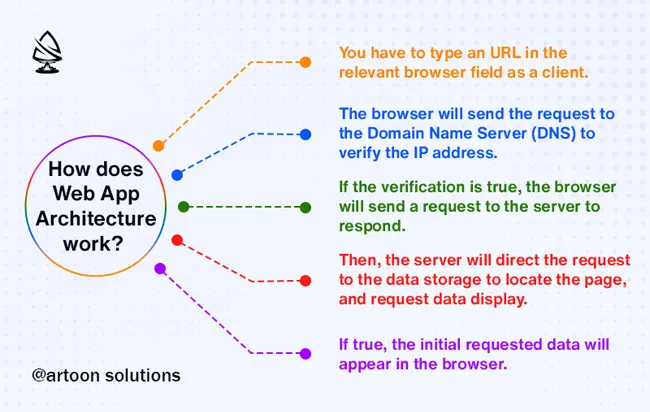- HR:+91-879-9184-787
- Sales:+91-832-0329-068

siteThe web app development market is an environment that is constantly evolving with new technologies & enhancing the standards of modern websites. Efficient, quality-induced web architecture can be the game changer for a product and even the whole business. It is nothing but a blueprint for data & information flow that can solve business problems effectively. A well-designed architecture retains user experience successfully and reduces the chances of the application crashing to avoid downtime.
Technically, it’s a skeleton of a web application development including its elements, databases, systems, servers, interfaces, and all the communication. To summarize, it indicates the logic behind responses to client and server requests.
Let’s understand more about web application architecture.
Web app development architecture is a blueprint of simultaneous interactions between an application’s components, databases, user interfaces, and servers.
How custom web app development service architecture operates differs between projects, as many of its aspects aren’t dictated by technology but by your project’s needs and business objectives. In other words, web app elements can be adjusted or changed entirely without affecting the overall success of your web app.
Read More: Which is the Better PHP Framework? Laravel Or Codeigniter

At the same time, the typical process of communicating with web app architecture is the following:
Market trends will keep changing, user expectations and demands will keep growing, and the progress of business is never-ending. The business architecture is the strong foundation that would lead to many successful events if designed with good patterns & derived approaches.
Read More: Web Application Development: Everything You Need to Know!

Currently, web app development architecture follows a layered architecture that contains Presentation, Business, Persistence, and Database layers.

Presentation Layer – It contains HTML, CSS, and JavaScript codes. All the front-end parts. It also enables the communication between the interface and the browser to establish user interaction.
Business Layer – It defines the business logic, rules, and business plans. It plays a large role in processing and executing business requests and sending it to the presentation layer.
Persistence Layer – It is also known as Data Access Layer.
Database Layer – It is also known as Data Service Layer that holds all the data and ensures data security. It segregates business logic from the client side.
A typical web application will consist of multiple components or we can say tiers that interact with each other. Generally, the two primary components of web app development service are as follows.
User Interface Components – This group of components composes a visual interface and has no ties to the architecture itself. Being a part of the interface layout design, the set of UI components includes activity logs, dashboards with analytics, and notifications.
Structural Web Components – It is further divided into two parts one is client components and the other is server components. Client components are developed with HTML, CSS, JavaScript, and Bootstrap and don’t need an operating system or device connectivity to operate.
Read More: 7 Most Popular Web App Development Frameworks to Use in 2023
A model for a web application can be designed based on two criteria: 1. Server, 2. Database. Choose the best one that fits your business needs. Here is a brief about the models of web applications.
This model says, if the server goes down so will your app. However, it is generally used for test practices and is a good option if you are a startup having budgetary constraints.
Perks of this model are: It is simple, relatively reliable, and relevant for testing.
In this model, the risk of data failure reduces as there is a backup server ready but the chances of website crash still exist as there is only one database.
The perks of this model are Stateless architecture, relative reliability, and multiple server availability.
This model reduces the app’s performance risk effectively since there are two options for database storage. You can either store identical data on all the databases or distribute it evenly among all servers.
Perks of this model are: It is efficient, it gives flexibility to the web application, and the backup & restore option (the entire web won’t be lost in case of failure).
Web application architecture is a pattern under which the app components interact with each other. To understand it properly, it shows the logic and lets the client and server communicate.

Generally, web application architecture is of 4 types.
The purpose of this architecture is to stay out of the limitations associated with web apps and deliver a performance-centric, intuitive, and interactive user experience.
Single-page applications load a single web page and reload the request data on the same page with dynamically updated content. In other words, it doesn’t refer to the server for loading new pages but sends requests for the needed parts of the webpage only.
This architecture is the best alternative to service-oriented & monolithic architecture. The business services are ready to be developed, tested, maintained, and deployed independently.
Monolithic architecture is a tiresome task because of its tightly coupled components. Microservices has resolved this issue by separating the application into multiple individual service components. It further simplifies the connectivity between service components and eliminates the need for service orchestration.
Read More: A Brief Guide to Web Application Development Cost
In this architecture, cloud service providers take responsibility for the whole execution of codes i.e., no need to deploy codes manually on your server. In this design pattern, applications are built and run without any manual intervention on the servers that are managed by largely popular third-party apps like Amazon and Microsoft.
BaaS lets developers focus on the front end, eliminating the operations performed on the back end. FaaS on the other hand is an event-driven model that allows web application developers to break the applications into small functions to focus on the code and event triggers.
It was google that introduced Progressive Web Apps (PWAs) in the year 2015 to develop apps that offer rich and native functionality with enhanced capabilities, and reliability. Progressive web apps are compatible apps with any browser and can run on any device. These apps are easily discoverable through URLs instead of the app store.
Some popular examples of PWAs are Uber, Starbucks, Pinterest, etc.
Personifying website application development architecture requires a professional and qualified architect who can understand the limitations and challenges that come along with it.
The success of modern website application development is always closely connected to its architecture. Keeping pace with changing requirements is a challenging task and a minor mistake can cost you the life of your product.
Currently, the world is filled with various bottom-level to best web app development companies. If you are looking for a progressive web app development company that can develop the best design for your web app, Artoon Solutions is the right place to move ahead.
Let’s connect!
Copyright 2009-2024
